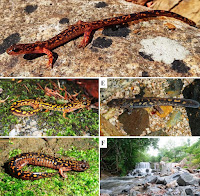 |
| Onychodactylus sillanus Min, Borzée, & Poyarkov, in Borzée, Shin, Poyarkov, Jeon, ... et Min, 2022. |
Species that are not formally described are generally not targets for conservation, regardless of their threatened status. While habitat degradation has increased over the past several decades in the Republic of Korea, taxonomic and conservation efforts continue to lag. For instance, a clade of Onychodactylus clawed salamanders from the extreme southeastern tip of the Korean Peninsula, which diverged ca. 6.82 million years ago from its sister species O. koreanus, is under intense anthropogenic pressure due to its extremely restricted range, despite its candidate species status. Here, using genetics, morphometrics, and landscape modeling, we confirmed the species status of the southeast Korean Onychodactylus population, and formally described it as Onychodactylus sillanus sp. nov. We also determined threats, habitat loss, and risk of extinction based on climatic models under different Representative Concentration Pathways (RCPs) and following the IUCN Red List categories and criteria. Based on several climate change scenarios, we estimated a decline in suitable habitat between 87.6% and 97.3% within the next three generations, sufficient to be considered Critically Endangered according to Category A3 of the IUCN Red List of Threatened Species. These findings should help enable the development of conservation programs and civic activities to protect the population. Conservation action plans are a priority to coordinate the activities required to protect this species.
 |
| Onychodactylus sillanus Republic of Korea, in life. A: adult male from North Gyeongsang Province, Yangsan-si; B: subadult paratype (CGRB 15907) from North Gyeongsang Province, Unmun Mountain. |
Onychodactylus sillanus sp. nov. Min, Borzée, & Poyarkov
Diagnosis: A slender, medium-sized hynobiid salamander and member of the genus Onychodactylus based on a combination of the following morphological features: lungs absent; black claw-like keratinous structures present on both fore- and hindlimbs in larvae and breeding adults; tail longer than sum of head and body lengths, tail in adults almost cylindrical at base, slightly compressed laterally at distal end; vomerine teeth in transverse row of short arch-shaped series in contact with each other; larvae with skinfolds on posterior edges of both fore- and hindlimbs; breeding males with dermal flaps on posterior edges of hindlimbs; other typical features of genus. The new species can be diagnosed from other members of the genus by the following combination of adult characters: 11–12 costal grooves; vomerine teeth in two comparatively shallow, slightly curved series with 18–22 teeth in each, in contact medially; outer branches of vomerine tooth series slightly longer than inner branches and outer ends of series located more posteriorly than anterior ends; dark ground dorsum, head and tail (slate-black to brown) with numerous, medium-sized (size<SVL/20) yellowish to reddish-orange confluent elongated spots and ocelli, ventral side purplish gray; light dorsal band always absent; juveniles with dark ventral trunk, large yellowish blotches on dorsum and tail.
Etymology: The specific name “sillanus” is a toponymic adjective in the nominative singular, masculine gender, referring to the historical Korean Kingdom of Silla (57 BC–935 AC) located on the southeastern parts of the Korean Peninsula, coinciding with the geographic distribution of the new species.
Common names: We suggest “Yangsan Clawed Salamander” as the common name in English and “Yangsan Ggorichire Dorongnyong” (Kkorichire Dorongnyong) (양산꼬리치레도롱뇽) as the common name in Korean, in reference to its distribution.
Amaël Borzée, Yucheol Shin, Nikolay A. Poyarkov, Jong Yoon Jeon, Hae Jun Baek, Chang Hoon Lee, Junghwa An, Yoon Jee Hong and Mi-Sook Min. 2022. Dwindling in the Mountains: Description of A Critically Endangered and Microendemic Onychodactylus Species (Amphibia, Hynobiidae) from the Korean Peninsula. Zoological Research. 43(5); 750-755. DOI: 10.24272/j.issn.2095-8137.2022.048





